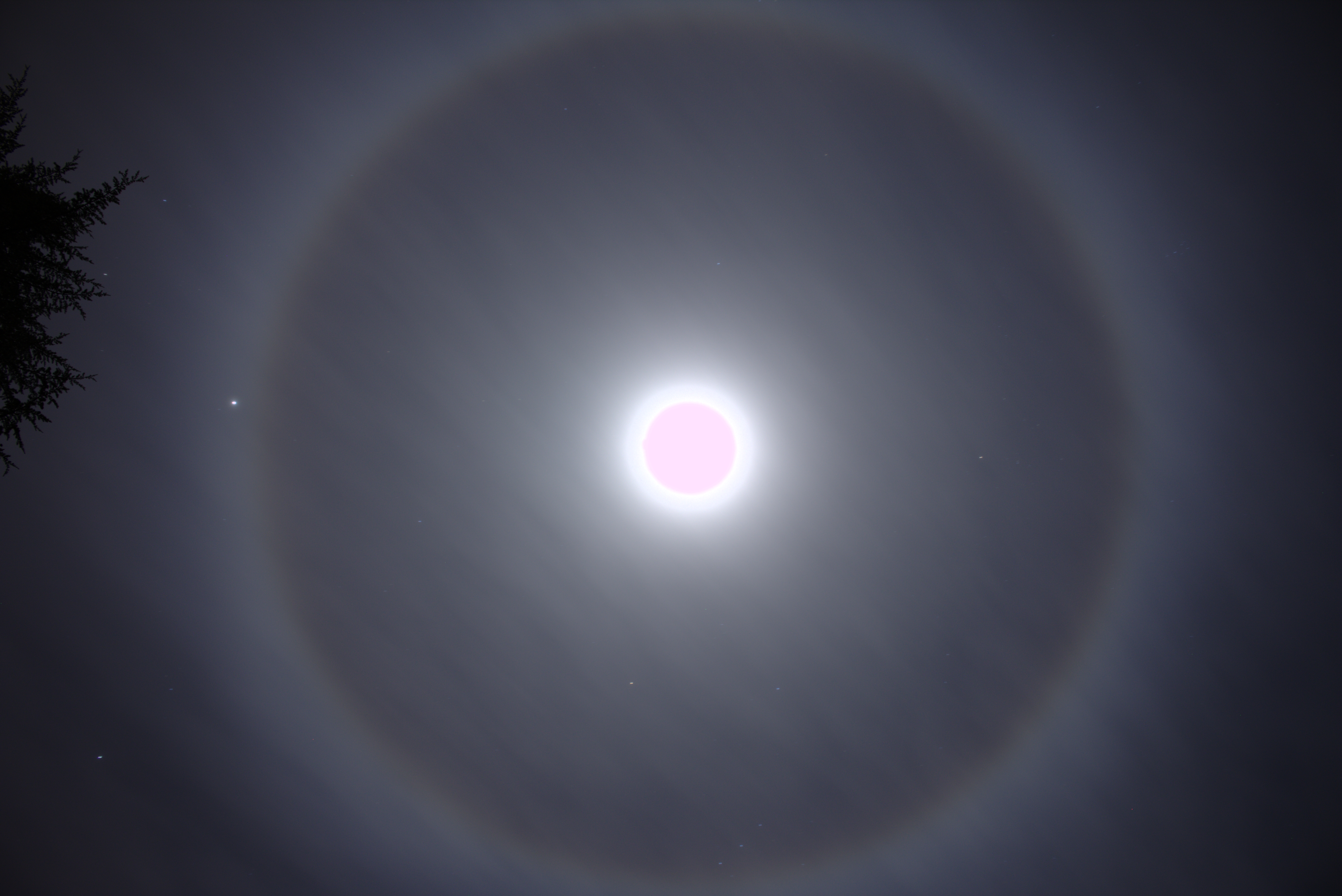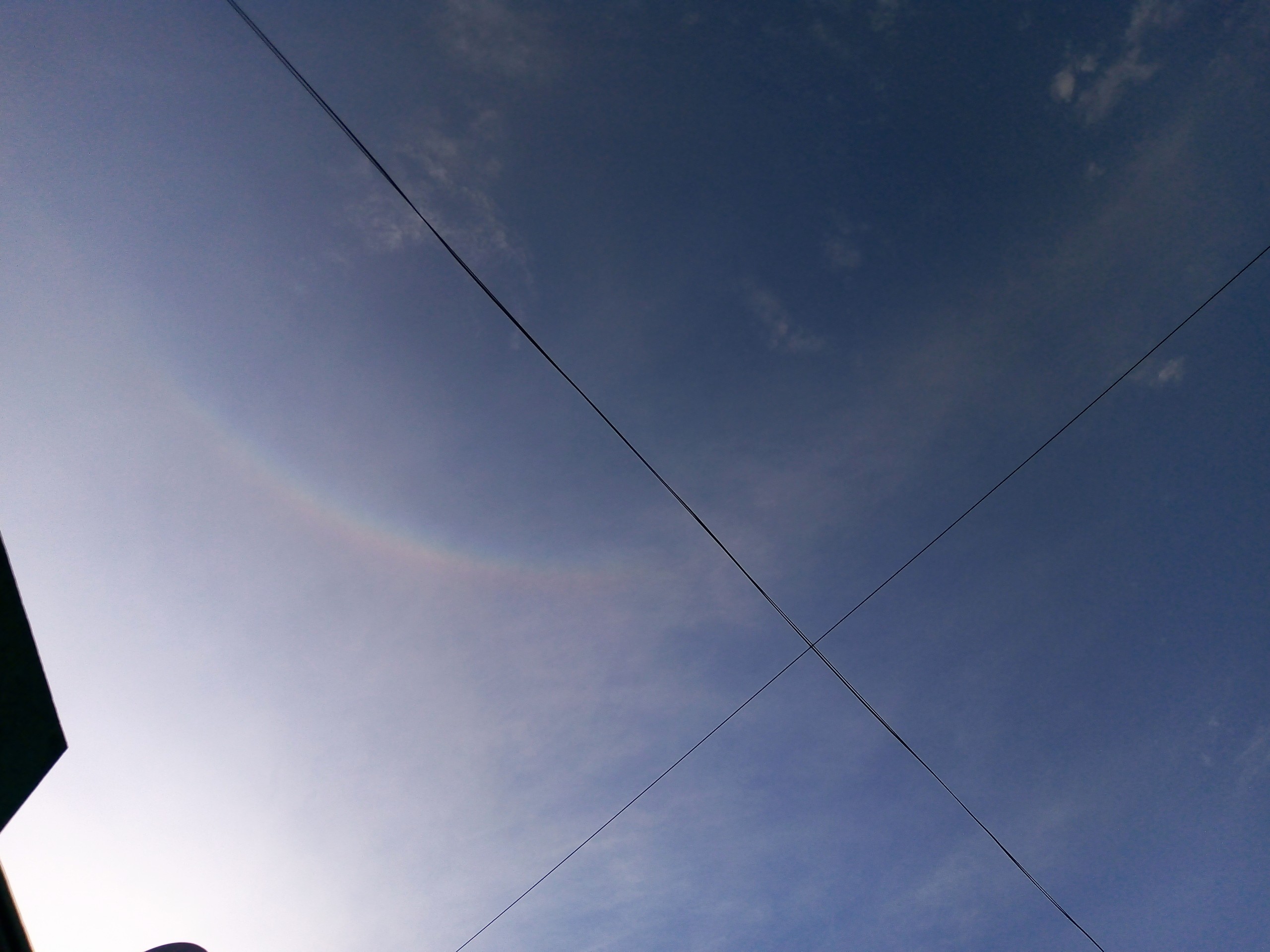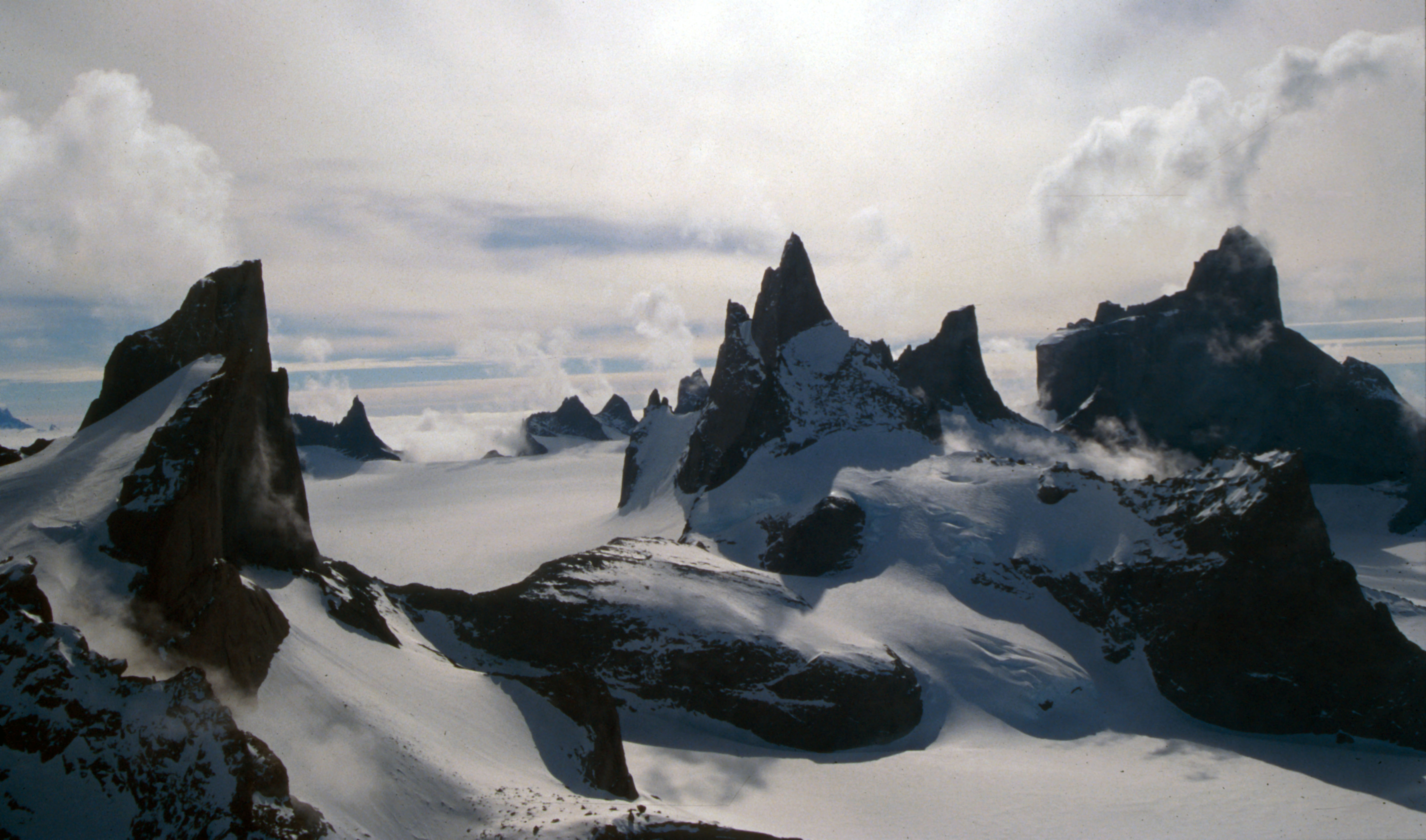|
Liljequist Parhelion
A Liljequist parhelion is a rare halo, an optical phenomenon in the form of a brightened spot on the parhelic circle approximately 150–160° from the sun; i.e., between the position of the 120° parhelion and the anthelion. While the sun touches the horizon, a Liljequist parhelion is located approximately 160° from the sun and is about 10° long. As the sun rises up to 30° the phenomenon gradually moves towards 150°, and as the sun reaches over 30° the optical effect vanishes. The parhelia are caused by light rays passing through oriented plate crystals. . The phenomenon was first observed by Gösta Hjalmar Liljequist in 1951 at Maudheim, Antarctica during the Norwegian–British–Swedish Antarctic Expedition in 1949–1952. It was then simulated by Dr. Eberhard Tränkle (1937–1997) and Robert Greenler in 1987 and theoretically explained by Walter Tape in 1994. A theoretical and experimental investigation of the Liljequist parhelion caused by perfect hexagonal plate ... [...More Info...] [...Related Items...] OR: [Wikipedia] [Google] [Baidu] |
Halo (optical Phenomenon)
A halo is an optical phenomenon produced by light (typically from the Sun or Moon) interacting with ice crystals suspended in the atmosphere. Halos can have many forms, ranging from colored or white rings to arcs and spots in the sky. Many of these appear near the Sun or Moon, but others occur elsewhere or even in the opposite part of the sky. Among the best known halo types are the circular halo (properly called the 22° halo), light pillars, and sun dogs, but many others occur; some are fairly common while others are extremely rare. The ice crystals responsible for halos are typically suspended in cirrus or cirrostratus clouds in the upper troposphere (), but in cold weather they can also float near the ground, in which case they are referred to as diamond dust. The particular shape and orientation of the crystals are responsible for the type of halo observed. Light is reflected and refracted by the ice crystals and may split into colors because of dispersion. The ... [...More Info...] [...Related Items...] OR: [Wikipedia] [Google] [Baidu] |
Optical Phenomenon
Optical phenomena are any observable events that result from the interaction of light and matter. All optical phenomena coincide with quantum phenomena. Common optical phenomena are often due to the interaction of light from the sun or moon with the atmosphere, clouds, water, dust, and other particulates. One common example is the rainbow, when light from the sun is reflected and refracted by water droplets. Some phenomena, such as the green ray, are so rare they are sometimes thought to be mythical. Others, such as Fata Morganas, are commonplace in favored locations. Other phenomena are simply interesting aspects of optics, or optical effects. For instance, the colors generated by a prism are often shown in classrooms. List Optical phenomena include those arising from the optical properties of the atmosphere; the rest of nature (other phenomena); of objects, whether natural or human-made (optical effects); and of our eyes (Entoptic phenomena). Also listed here are unexpla ... [...More Info...] [...Related Items...] OR: [Wikipedia] [Google] [Baidu] |
Parhelic Circle
A parhelic circle is a type of halo, an optical phenomenon appearing as a horizontal white line on the same altitude as the sun, or occasionally the Moon. If complete, it stretches all around the sky, but more commonly it only appears in sections. If the halo occurs due to light from the moon rather than the sun, it is known as a paraselenic circle. Even fractions of parhelic circles are less common than sun dogs and 22° halos. While parhelic circles are generally white in colour because they are produced by reflection, they can however show a bluish or greenish tone near the 120° parhelia and be reddish or deep violet along the fringes. (including an excellent HaloSim simulation of a parhelic circle.) Parhelic circles form as beams of sunlight are reflected by vertical or almost vertical hexagonal ice crystals. The reflection can be either external (e.g. without the light passing through the crystal) which contributes to the parhelic circle near the sun, or internal (one or ... [...More Info...] [...Related Items...] OR: [Wikipedia] [Google] [Baidu] |
120° Parhelion
A 120° parhelion (plural: 120° parhelia) is a relatively rare halo, an optical phenomenon occasionally appearing along with very bright sun dogs (also called parhelia) when ice crystal-saturated cirrus clouds fill the atmosphere. The 120° parhelia are named for appearing in pair on the parhelic circle ±120° from the sun. (including a HaloSim simulation.) When visible, 120° parhelia appear as white-bluish bright spots on the white parhelic circle and are the product of at least two interior reflections in the hexagonal ice crystals. Their colour together with them being rather obscure can make observing them difficult as they tend to fuse with the clouds in the sky. See also * Liljequist parhelion A Liljequist parhelion is a rare halo, an optical phenomenon in the form of a brightened spot on the parhelic circle approximately 150–160° from the sun; i.e., between the position of the 120° parhelion and the anthelion. While the sun touches ... * Subhelic arc Referen ... [...More Info...] [...Related Items...] OR: [Wikipedia] [Google] [Baidu] |
Anthelion
An anthelion (plural anthelia, from late Greek ανθηλιος, "opposite the sun") is a rare optical phenomenon of the halo family. It appears on the parhelic circle opposite to the sun as a faint white spot, not unlike a sundog, and may be crossed by an X-shaped pair of diffuse arcs. How anthelia are formed is disputed. Walter Tape, among others, has argued they are not separate haloes, but simply where various haloes caused by horizontally oriented column-shaped ice crystals coincide on the parhelic circle to create a bright spot. If this theory is correct, anthelia should only appear together with these other haloes. However, anthelia occur unaccompanied by other plate crystal haloes, thus scientists have produced alternative explanations. The Dutch professor S.W. Visser proposed they form by two exterior light reflections in quadrangular prisms, while Robert Greenler has suggested two interior reflections in column-shaped crystals produces the phenomenon. While the ant ... [...More Info...] [...Related Items...] OR: [Wikipedia] [Google] [Baidu] |
Plate Crystal
Plate may refer to: Cooking * Plate (dishware), a broad, mainly flat vessel commonly used to serve food * Plates, tableware, dishes or dishware used for setting a table, serving food and dining * Plate, the content of such a plate (for example: rice plate) * Plate, to present food, on a plate * Plate, a forequarter cut of beef Places * Plate, Germany, a municipality in Parchim, Mecklenburg-Vorpommern, Germany * River Plate (other) * Tourelle de la Plate, a lighthouse in France Science and technology Biology and medicine * Plate (anatomy), several meanings * Dental plate, also known as dentures * Dynamic compression plate, a metallic plate used in orthopedics to fix bone * Microtiter plate (or microplate or microwell plate), a flat plate with multiple "wells" used as small test tubes * Petri dish or Petri plate, a shallow dish on which biological cultures may be grown and/or viewed Geology * Tectonic plate, are pieces of Earth's crust and uppermost mantle, to ... [...More Info...] [...Related Items...] OR: [Wikipedia] [Google] [Baidu] |
Ice Crystal
Ice crystals are solid ice exhibiting atomic ordering on various length scales and include hexagonal columns, hexagonal plates, dendritic crystals, and diamond dust. Formation The hugely symmetric shapes are due to depositional growth, namely, direct deposition of water vapor onto the ice crystal. Depending on environmental temperature and humidity, ice crystals can develop from the initial hexagonal prism into numerous symmetric shapes. Possible shapes for ice crystals are columns, needles, plates and dendrites. If the crystal migrates into regions with different environmental conditions, the growth pattern may change, and the final crystal may show mixed patterns. Ice crystals tend to fall with their major axis aligned along the horizontal, and are thus visible in polarimetric weather radar signatures with enhanced (positive) differential reflectivity values. Electrification of ice crystals can induce alignments different from the horizontal. Electrified ice crystals are ... [...More Info...] [...Related Items...] OR: [Wikipedia] [Google] [Baidu] |
Gösta Hjalmar Liljequist
Gösta Hjalmar Liljequist (1914–1995) was a Swedish meteorologist. In Sweden, radio broadcast weather forecasts begun in 1926, and, starting in 1941, Liljequist was one of the recurrent meteorologists appearing in Swedish radio for many years. Following his debut, his peculiar dialect caused mass protests which, together with an attack published by the humorist Kar de Mumma in the paper Svenska Dagbladet ''Svenska Dagbladet'' (, "The Swedish Daily News"), abbreviated SvD, is a daily newspaper published in Stockholm, Sweden. History and profile The first issue of ''Svenska Dagbladet'' appeared on 18 December 1884. During the beginning of the ..., caused broadcast forecasts to be taken over by Swedish public service radio during the war. After the war, Liljequist took part in the Norwegian-British-Swedish Antarctic Expedition (NBSAE) (1949-1952). During the expedition he became the first to observe a rare type of halo, an optical phenomenon subsequently named Lilj ... [...More Info...] [...Related Items...] OR: [Wikipedia] [Google] [Baidu] |
Maudheim Station
Queen Maud Land ( no, Dronning Maud Land) is a roughly region of Antarctica claimed by Norway as a dependent territory. It borders the claimed British Antarctic Territory 20° west and the Australian Antarctic Territory 45° east. In addition, a small unclaimed area from 1939 was annexed in June 2015. Positioned in East Antarctica, it makes out about one-fifth of the continent, and is named after the Norwegian queen Maud of Wales (1869–1938). In 1930, the Norwegian Hjalmar Riiser-Larsen was the first person known to have set foot in the territory. On 14 January 1939, the territory was claimed by Norway. On 23 June 1961, Queen Maud Land became part of the Antarctic Treaty System, making it a demilitarised zone. It is one of two Antarctic claims made by Norway, the other being Peter I Island. They are administered by the Polar Affairs Department of the Norwegian Ministry of Justice and Public Security in Oslo. Most of the territory is covered by the east Antarctic ice she ... [...More Info...] [...Related Items...] OR: [Wikipedia] [Google] [Baidu] |
Antarctica
Antarctica () is Earth's southernmost and least-populated continent. Situated almost entirely south of the Antarctic Circle and surrounded by the Southern Ocean, it contains the geographic South Pole. Antarctica is the fifth-largest continent, being about 40% larger than Europe, and has an area of . Most of Antarctica is covered by the Antarctic ice sheet, with an average thickness of . Antarctica is, on average, the coldest, driest, and windiest of the continents, and it has the highest average elevation. It is mainly a polar desert, with annual precipitation of over along the coast and far less inland. About 70% of the world's freshwater reserves are frozen in Antarctica, which, if melted, would raise global sea levels by almost . Antarctica holds the record for the lowest measured temperature on Earth, . The coastal regions can reach temperatures over in summer. Native species of animals include mites, nematodes, penguins, seals and tardigrades. Where ve ... [...More Info...] [...Related Items...] OR: [Wikipedia] [Google] [Baidu] |
Norwegian–British–Swedish Antarctic Expedition
The Norwegian–British–Swedish Antarctic Expedition (also known as NBSX or NBSAE) (1949–1952) was the first Antarctica expedition involving an international team of scientists. The team members came from Norway, Sweden and the British Commonwealth of Nations. History The Norwegian–British–Swedish Antarctic Expedition was the first expedition to Antarctica involving an international team of scientists. The expedition was led by John Schjelderup Giæver, a Norwegian author and polar researcher. The expedition had the goal of establishing whether climatic fluctuations observed in the Arctic were also occurring in the Antarctic. A base known as Maudheim was established on the Quar Ice Shelf along the coast of Queen Maud Land in February 1950. This expedition laid the groundwork for the following Australian expeditions to Antarctic from 1954 to the early 1960s. Transportation The expedition was transported aboard a 600-ton sealer named that was powered by a German U-boat dies ... [...More Info...] [...Related Items...] OR: [Wikipedia] [Google] [Baidu] |
Sun Dog
A sun dog (or sundog) or mock sun, also called a parhelion (plural parhelia) in meteorology, is an atmospheric optical phenomenon that consists of a bright spot to one or both sides of the Sun. Two sun dogs often flank the Sun within a 22° halo. The sun dog is a member of the family of halos caused by the refraction of sunlight by ice crystals in the atmosphere. Sun dogs typically appear as a pair of subtly colored patches of light, around 22° to the left and right of the Sun, and at the same altitude above the horizon as the Sun. They can be seen anywhere in the world during any season, but are not always obvious or bright. Sun dogs are best seen and most conspicuous when the Sun is near the horizon. Formation and characteristics Sun dogs are commonly caused by the refraction and scattering of light from horizontally oriented plate-shaped hexagonal ice crystals either suspended in high and cold cirrus or cirrostratus clouds, or drifting in freezing moist air at low ... [...More Info...] [...Related Items...] OR: [Wikipedia] [Google] [Baidu] |





